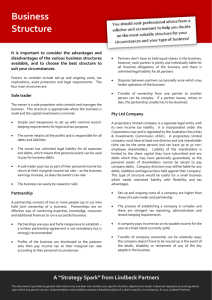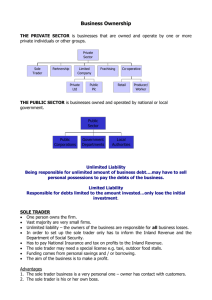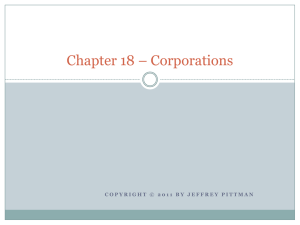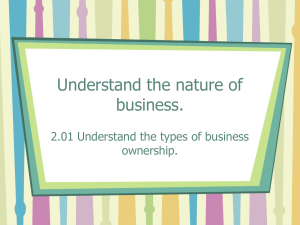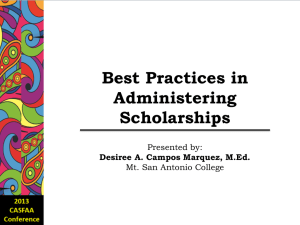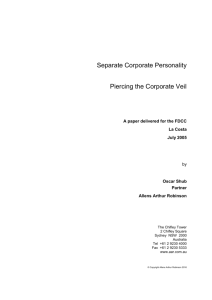2_-_legal_personality_1_
advertisement
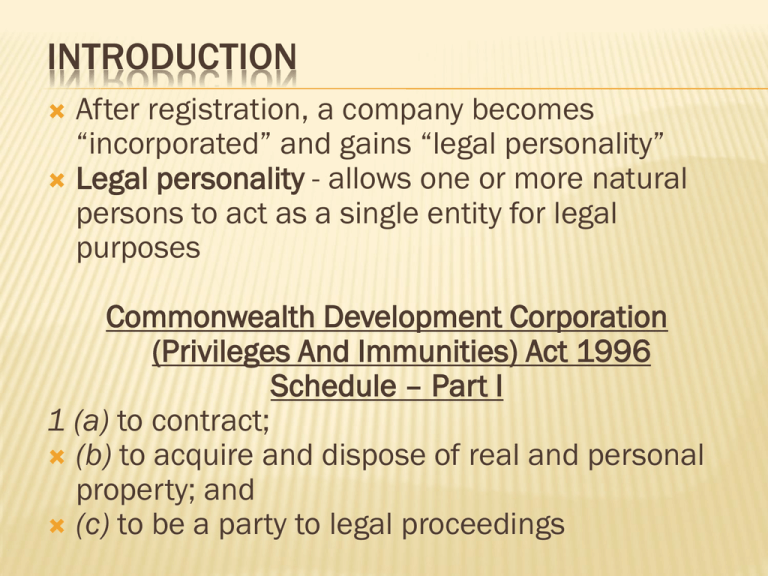
INTRODUCTION After registration, a company becomes “incorporated” and gains “legal personality” Legal personality - allows one or more natural persons to act as a single entity for legal purposes Commonwealth Development Corporation (Privileges And Immunities) Act 1996 Schedule – Part I 1 (a) to contract; (b) to acquire and dispose of real and personal property; and (c) to be a party to legal proceedings TYPES OF LEGAL ENTITIES 1. Sole Proprietorship/Sole Trader 2. Partnership 3. Owned and run by one owner Owner and business are one and the same Association of owners in an unincorporated company Corporation a group of people authorised by law to act as a legal personality Separate powers, duties, and liabilities TYPES OF LIABILITIES Limited Liability – Registered under the Companies Act 1995, as amended Financial responsibility is restricted to the company Personal assets cannot be used to pay company debts Unlimited Liability – Not registered Indefinite extent of liability to pay the company’s debts Extends beyond investments in company to personal assets UNLIMITED LIABILITY Sole Trader Total personal liability for business debts Partnerships Unlimited liability for debts unless registered as a Limited Liability Partnership (LLP) All will be liable even if one partner’s actions caused the business to be sued LIMITED LIABILITY Types of companies with Limited Liability 1.Corporations 2.Limited Liability Partnership (LLP) Limited Liability Corporation (LLC) – United States variation Debt responsibility is limited to his/her share of investment in the business If the business is sued or forced to close, the personal assets are safe CORPORATE LIABILITY 1. Strict liability - Legally responsible for damages or loss caused by act or omission, despite fault. Just need to prove causal link 2. Vicarious liability – Employers are vicariously (clearly/openly) liable, under the respondeat superior doctrine, for negligent acts or omissions by their employees in the course of employment 3. Primary liability: the organic theory • Tesco Supermarkets Ltd v Nattrass [1972] AC 153 SALOMON PRINCIPLE House of Lords judgement in Salomon v. A. Salomon & Co. Ltd. (1897) AC 22 One of the fundamental principles of company law is that a company has a personality that is distinct from that of its shareholders. SALOMON PRINCIPLE Advantages: One contract, instead of multiple contracts for all shareholders Personal property is protected after failure of the business Disadvantages: Lack of ethics by shareholders. If the company fails, they aren’t personally affected Outside investors are the real losers. THE CORPORATE VEIL The “Veil of Incorporation” protects members from being held responsible for the company liabilities PIERCING/LIFTING THE CORPORATE VEIL This is used to avoid abuse of the separate identity principle: a) b) c) d) e) Human Characteristics Fraud Avoidance of legal duty Agency Single economic Entity HUMAN CHARACTERISTIC The veil will be lifted if the company displays a human characteristic Director acts or makes a decision independently from the company Signs cheque/contract/other document in his/her name and not company’s name Can also happen if advice is negligently given by a Director, but it must meet the “Hedley Byrne” requirements. FRAUD The corporate veil may be lifted where the company is used to perpetuate a fraud: Re Darby; ex p Broughton [1911] 1 KB 95 AVOIDANCE OF LEGAL DUTY (1) Gilford Motor Co. Ltd. v Horne [1933] Ch 935 Mr. Horne’s contract stated that if he left Gilford Motor, he was not allowed to solicit customers. He set up a company offering a cheaper price, but after legal consultation, he was told that it was still illegal. AVOIDANCE OF LEGAL DUTY (2) He then started a new company in the names of his wife and friend thinking that “technically” he wasn’t breaching the clause in the previous employment contract because (1) this was a company and (2) it was not in his name. The Court of Appeal held that the business was a sham to circumvent the covenant in his previous employment contract AGENCY (1) Smith, Stone & Knight Ltd v. Birmingham Corporation [1939] 4 All ER 116 The parent company had full and exclusive access to the subsidiary’s books; the subsidiary had no employees other than a manager; it occupied the parent’s premises for no consideration, and the only evidence of its purportedly independent existence was its name on the stationery. AGENCY (2) The following 6 questions will determine whether a company is carrying on its own business or at of the parent company: (i) Were the profits of the subsidiary those of the parent company? (ii) Were the persons conducting the business of the subsidiary appointed by the parent company? (iii) Was the parent company the “head and brains” of the venture? (iv) Did the parent company govern the venture? (v) Were the profits made by the subsidiary company made by the skill and direction of the parent company? (vi) Was the parent company in effective and constant control of the subsidiary? AGENCY (3) The exception was followed in Spreag v Paeson Pty Ltd (1990) 94 ALR 67 when the word “puppet” was used to describe the subsidiary. SINGLE ECONOMIC ENTITY (1) Roskill LJ in The Albazero [1977] AC 774, 807 Each company in a group of companies is a separate legal entity with separate rights and responsibilities The Roberta (1937) 58 LI LR 159 However, the veil may be lifted to look at the economic reality of the situation; i.e., does the holding company control and dictate? SINGLE ECONOMIC ENTITY (2) But… Robert Goff LJ in Bank of Tokyo Ltd. v Karoon [1987] AC 45n: “… we are concerned not with economics, but with law. The distinction between the two is, in law, fundamental and cannot here be abridged.” Then… Adams v Cape Industries plc [1990] Ch 433 - The holding company is separate from its subsidiaries CONSEQUENCES OF LEGAL PERSONALITY 1. The ability of the firm to sue and be sued: Lee v Lee's Air Farming) 2. Transfer of property: Farrar v Farrar's Ltd) 3. Insurable interests: Macaura v Northern Trust Assurance Co Ltd 4. Compensation: Shareholders cannot get compensation for company failure O'Neill v Ryan et al (1993) I.L.R.M. 557 5. OTHER CONSEQUENCES Limited liability Perpetual succession Liability in tort and crime The rule in Foss v Harbottle (1843)– individual shareholders can’t sue; the company must sue SOLE TRADER - ADVANTAGES No legal filing requirements or fees and no professional advice is needed to set it up. You just literally go into business on your own. Simplicity – one person does not need a complex organisational structure. SOLE TRADER - DISADVANTAGES Not a particularly useful business form for raising capital (money). For most sole traders the capital will be provided by personal savings or a bank loan. Unlimited liability – the most important point to note in terms of comparing this form to the company in that there is no difference between the sole trading business and the sole trader himself. The profits of the business belong to the sole trader but so do the losses. As a result he has personal liability for all the debts of the business. PARTNERSHIP - ADVANTAGES No formal legal filing requirement involved in becoming a partnership beyond the minimum requirement that there be two members of the partnership. Easier to obtain capital as there can be up to 20 members of the partnership, all of whom could pool their investment within the partnership. COMPANY - ADVANTAGES Companies are designed to make it easy to raise capital. Companies have the ability to subdivide their capital into small amounts, allowing them to draw in huge numbers of investors who also benefit from the sub-division by being able to sell on small parts of their investment. Limited liability also minimises the risk for investors and is said to encourage investment. COMPANY – ADVANTAGES (CONT.) It is also said to allow managers to take greater risk in the knowledge that the shareholders will not lose everything. The constitution of the company provides a clear organisational structure which is essential in a business venture where you have large numbers of participants. COMPANY - DISADVANTAGES Forming a company and complying with company law is expensive and time consuming. It also appears to be a very complex organisational form for small businesses, where the Board of Directors and the shareholders are often the same people

